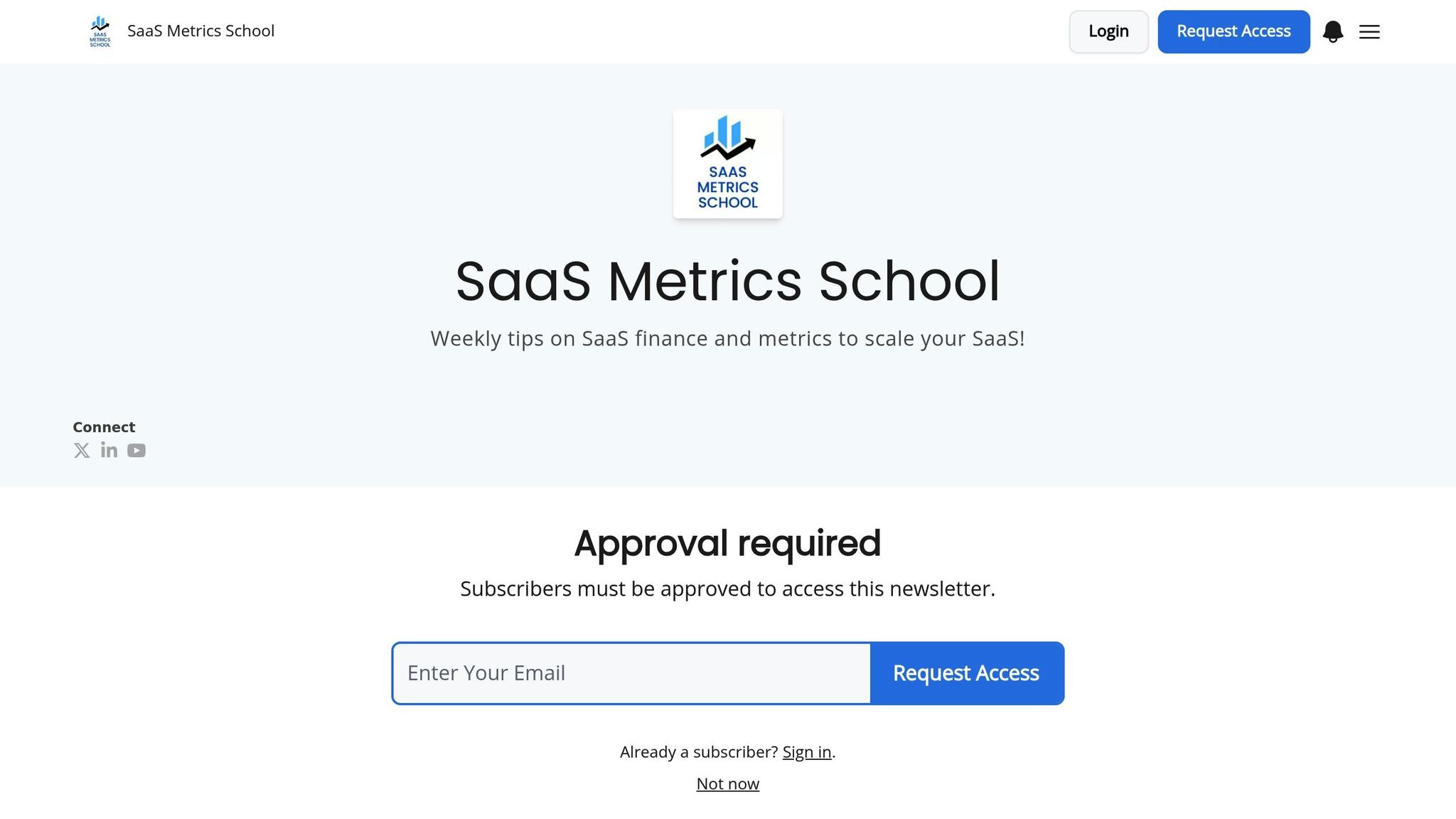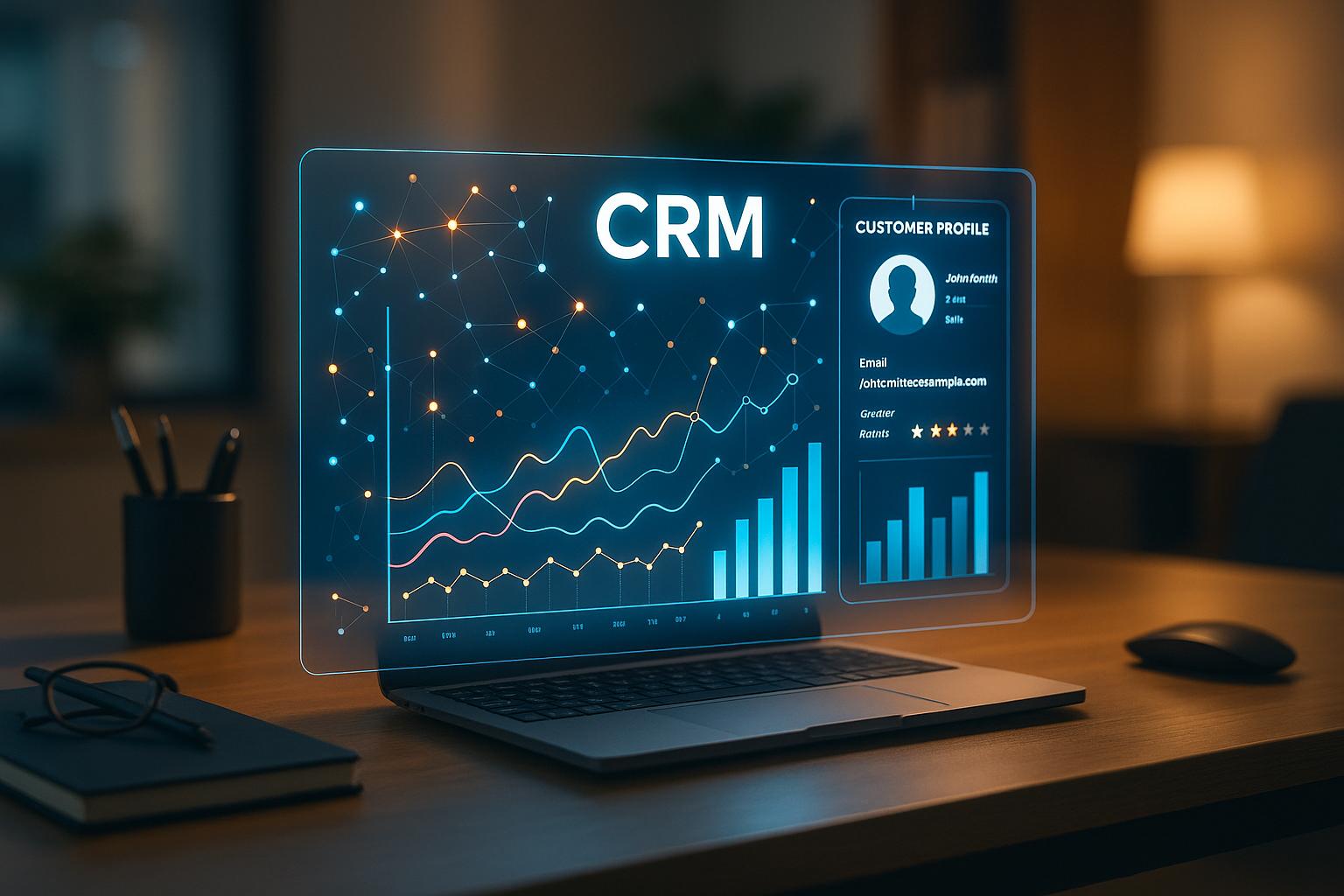AI-enabled SaaS companies are valued significantly higher - 10× or more ARR - compared to traditional SaaS firms stuck at 4-6×. The reason? AI boosts efficiency, lowers costs, and enhances customer retention, making these businesses more scalable and attractive to investors. Key metrics like Net Revenue Retention (NRR), Customer Acquisition Cost (CAC), and growth rates improve with AI, driving higher valuations.
Quick Takeaways:
- Higher Multiples: AI-driven firms command 10×+ revenue multiples due to better performance across key metrics.
- Efficiency Gains: AI reduces costs, improves customer retention, and scales operations without proportional cost increases.
- Investor Appeal: AI creates a competitive moat, lowers risks, and delivers measurable business outcomes.
For SaaS founders, integrating AI is no longer optional - it’s the key to unlocking premium valuations and staying competitive in today’s market.
Understanding SaaS Valuations: How to Navigate the 3x to 10x ARR Range | SaaS Metrics School

The SaaS Valuation Market in 2025
By 2025, SaaS companies leveraging AI technology are reaping the rewards of higher valuations. While the broader market has settled after past fluctuations, one trend stands out: AI-enabled SaaS firms consistently command higher valuations than their traditional counterparts.
In public markets, traditional SaaS businesses trade at moderate revenue multiples. Meanwhile, AI-enabled firms enjoy premium valuations, reflecting their technological edge. The private market follows a similar trajectory, with venture capital and private equity firms offering higher valuations to companies that deeply integrate AI into their operations. For example, Series B and later-stage funding rounds for AI-focused SaaS companies often close at levels previously reserved for much larger traditional firms. These trends are reshaping growth expectations and competitive dynamics across the SaaS sector.
Key Metrics Driving SaaS Valuation
Certain metrics are pushing AI-enabled SaaS firms to the forefront of valuation rankings. Metrics like Annual Recurring Revenue (ARR) growth, Net Revenue Retention (NRR), Customer Acquisition Cost (CAC), and gross margins are all seeing significant boosts thanks to AI-driven efficiencies.
AI-powered automation plays a pivotal role in improving NRR and gross margins. By streamlining customer support, eliminating manual workflows, and optimizing resource allocation, these companies achieve better unit economics, which in turn supports higher valuations.
CAC payback periods are under sharper scrutiny as investors prioritize capital efficiency. AI-enabled firms excel here, reducing CAC payback times through tools like enhanced lead scoring, tailored marketing strategies, and streamlined sales operations. These improvements not only make them more competitive but also more appealing to investors.
Growth Rates and Valuation Multiples
Growth rates are becoming increasingly tied to valuation multiples. While high-growth traditional SaaS companies still receive moderate revenue multiples, AI-enabled firms with similar growth rates command noticeably higher ones. This reflects investor confidence in the long-term sustainability and efficiency of AI-driven business models.
For companies with slower growth, the valuation gap widens further. Traditional SaaS firms face challenges securing favorable multiples, while AI-enabled companies continue to attract elevated valuations. This suggests that AI integration provides a buffer against slowing growth by improving operational efficiency and customer retention.
Investors are also raising the bar for performance benchmarks. AI-enabled companies are expected to deliver stronger growth and profitability metrics, thanks to the operational advantages that AI offers. These shifting expectations are creating a clear divide in how traditional and AI-driven firms are valued.
Traditional vs. AI-Enabled SaaS Valuations
The valuation disparity between traditional and AI-enabled SaaS firms is stark. While traditional companies often operate efficiently, they lack the scalability and automation that define AI-enabled businesses. This difference is key to understanding why AI-driven firms secure premium valuations.
AI-enabled SaaS companies have a unique edge. They can serve larger customer bases with fewer resources, predict and address customer churn more effectively, and continuously improve their products using real-world data. This ability to automate, optimize, and anticipate creates a competitive moat that aligns perfectly with the metrics investors prioritize.
How AI Integration Drives Higher Valuations
AI is reshaping SaaS businesses by directly improving the metrics investors care about most. It’s not just about adding trendy features - it’s about fundamentally transforming operations to deliver measurable results. Let’s explore how AI drives these impactful changes.
How AI Enhances Operational Efficiency
AI doesn’t just streamline processes; it redefines how businesses operate. Take customer support, for example. AI chatbots and automated ticket routing ensure faster response times, reduce costs, and improve customer satisfaction. These tools allow teams to handle more queries without scaling up headcount.
In sales, AI-driven tools like lead scoring and pipeline management analyze customer behavior and engagement patterns. This helps sales teams zero in on the most promising leads, increasing conversion rates. On the marketing side, AI-powered automation enables precise customer segmentation, resulting in more targeted and effective campaigns.
The result? Lower customer acquisition costs, improved gross margins, and happier customers. These operational efficiencies also contribute to stronger customer retention - key factors that make a company more attractive to investors.
AI’s Role in Strengthening Net Revenue Retention
Net Revenue Retention (NRR) is a critical metric for SaaS businesses, and AI plays a pivotal role in improving it. Predictive analytics can identify customers at risk of churning, enabling businesses to intervene with tailored strategies. Whether it’s personalized upselling or cross-selling, AI helps boost revenue while reducing churn.
Dynamic pricing models powered by real-time customer and market data further optimize revenue. By continuously adapting to changing conditions, these models maximize profitability and strengthen customer relationships. Together, these AI-driven strategies enhance NRR, signaling to investors that the business has a strong product-market fit and sustainable growth potential.
Building Competitive Advantages with AI
AI doesn’t just improve efficiency - it creates lasting competitive advantages. As AI systems process more customer data, they become better at delivering personalized recommendations and predicting needs. This creates a feedback loop that improves service quality and deepens customer loyalty. Proprietary data adds another layer of protection, making it harder for competitors to lure customers away.
AI also accelerates innovation. By analyzing user feedback and identifying feature gaps, AI helps companies prioritize product updates and roll out improvements faster. This speed and precision keep customers satisfied and engaged.
On top of that, AI’s scalability allows businesses to serve more customers with smaller teams, boosting operational leverage. These factors - personalization, innovation, and scalability - combine to create a strong moat, ensuring long-term market dominance.
For investors, all of this translates into higher valuations. Companies that demonstrate sustainable growth, operational efficiency, and unique competitive advantages are rewarded with premium valuation multiples. AI isn’t just a tool for SaaS businesses - it’s a game-changer.
sbb-itb-9cd970b
Building AI Capabilities to Increase Valuation
Implementing AI effectively involves a clear strategy: pinpoint opportunities, apply practical tools, and track results that resonate with investors. Strengthening AI capabilities bridges the gap between improving operations and driving valuation growth.
Finding High-Impact AI Opportunities
Focus on areas where AI can make a measurable difference. Start with your customer acquisition funnel. AI-powered lead scoring can sharpen sales efforts, while chatbots work 24/7 to qualify leads without needing human input.
In customer success operations, predictive models can identify customers at risk of leaving, giving your team time to act. Analyzing user behavior offers insights into upselling opportunities, which can boost Net Revenue Retention - a key metric for investors.
For product development, AI can prioritize feature requests, predict updates that will engage users, and catch bugs early. This not only speeds up development but also fine-tunes product-market alignment.
The goal is to target tasks where AI reduces manual work and enhances results. Look for repetitive processes, data-heavy challenges, and areas where incremental improvements can stack up to significant gains over time.
AI Implementation Methods
Once opportunities are identified, many SaaS companies find it more efficient to adopt existing AI solutions rather than building from scratch. The market now offers a range of specialized, ready-to-use tools tailored to common business needs.
Pre-built platforms for customer support or marketing, for example, deliver quick results. These tools come with established integrations and proven performance, offering fast returns even if customization is limited.
For companies with unique needs or AI at the core of their product, custom AI development may be the better route. While this approach takes more time and expertise, it allows for tailored solutions. Many businesses take a hybrid approach - starting with off-the-shelf tools and gradually developing custom features as they grow.
API-first AI services are another option. They enable you to integrate advanced capabilities like natural language processing, image recognition, or predictive analytics without managing the underlying tech infrastructure.
Investors typically prefer seeing tangible AI-driven results quickly rather than waiting for long, drawn-out projects. A phased approach - starting small to demonstrate value and scaling from there - is often the best way forward.
Once implemented, the focus shifts to measuring AI’s impact.
Measuring ROI and Showing AI Value to Investors
Investors want to see how AI contributes to revenue, efficiency, and customer satisfaction. Your measurement framework should emphasize metrics that directly influence valuation.
Start with revenue impact. Track how AI initiatives like lead scoring or predictive analytics improve conversion rates, boost upselling, or reduce churn. Translating these outcomes into dollar figures helps clearly demonstrate how AI supports Annual Recurring Revenue growth.
Next, highlight operational efficiency gains. Show how AI minimizes staffing needs, speeds up processes, or improves accuracy. These efficiencies signal that your company is primed for growth without proportional cost increases.
Lastly, focus on customer satisfaction improvements. Metrics like Net Promoter Scores, faster support ticket resolution, and higher product adoption rates reflect a loyal customer base and increased lifetime value.
To make your case compelling, present clear before-and-after comparisons with defined timelines. For instance, instead of saying, "AI improved our sales process", show how AI-driven strategies increased conversion rates and added recurring revenue over a specific period.
Creating AI impact dashboards can also be a game-changer. By linking technical metrics to tangible business results, these dashboards help investors see that AI isn’t just an expense - it’s a driver of value, contributing to premium valuation multiples. This data-backed approach validates your AI strategy and reinforces your company’s growth potential.
Conclusion: Getting the AI Valuation Premium
To truly capitalize on the AI valuation premium, SaaS companies must understand and leverage the core differences between traditional and AI-enabled businesses. The disparity in valuation reflects how AI reshapes operations, scales more efficiently, and delivers value through improved net revenue retention, lower operational costs, and long-term competitive advantages. These are the traits that investors reward with higher revenue multiples.
Key Takeaways for SaaS Founders
- Use AI to transform your business fundamentals. The most successful SaaS companies leverage AI to cut customer acquisition costs, increase customer lifetime value, and improve gross margins by streamlining operations.
- Show measurable results. Investors want evidence of AI's impact on growth and efficiency. Focus on initiatives that directly improve metrics like revenue growth, customer retention, and operational performance.
- Create lasting advantages. Companies that integrate AI early and effectively build competitive barriers that grow stronger over time, making it harder for rivals to catch up.
- Prioritize quality data. Rich, well-maintained datasets enable superior AI models, which lead to better customer experiences. This creates a feedback loop where strong AI capabilities attract more customers, generating even more valuable data.
These strategies align with the improvements in ARR, NRR, and operational efficiency discussed earlier. The next step is to take actionable measures to close the valuation gap.
Next Steps to Close the Valuation Gap
Start by assessing your current operations for AI readiness. Look for areas where manual processes are resource-intensive, where customer data is underused, or where predictive analytics could enhance decision-making.
Focus on implementing high-impact AI initiatives that deliver quick, measurable results. Examples include AI-powered lead scoring, automated customer support, or tools that track customer health metrics. These efforts provide immediate ROI and demonstrate the tangible benefits of AI.
Establish clear benchmarks and dashboards from the outset. Track baseline metrics for the processes you aim to improve and tie AI initiatives directly to key business outcomes like cost savings, revenue growth, or higher customer satisfaction.
Finally, invest in the right expertise. Whether through training your team, hiring AI specialists, or collaborating with external partners, ensure your organization has the skills to implement and maintain AI systems effectively.
SaaS companies that embrace AI as a strategic priority position themselves to close the valuation gap and gain a competitive edge. With the tools and platforms available today, there’s no better time to start your AI transformation. Those who act decisively and thoughtfully stand to achieve a substantial valuation premium.
FAQs
How does AI help SaaS companies improve metrics like Net Revenue Retention (NRR) and Customer Acquisition Cost (CAC)?
AI plays a powerful role in improving critical SaaS metrics like Net Revenue Retention (NRR) and Customer Acquisition Cost (CAC) by streamlining processes and delivering more value. With AI, companies gain deeper insights into customer behavior, uncover upselling opportunities, and provide tailored experiences. These strategies not only enhance customer satisfaction but also drive retention and revenue growth - two major contributors to better NRR.
AI-powered automation also cuts down on repetitive tasks and eliminates inefficiencies, which helps reduce operational costs for both businesses and their customers. By showcasing clear returns on investment through increased productivity and cost savings, SaaS companies can justify premium subscription rates and attract new customers more effectively. This, in turn, helps lower CAC.
How can a traditional SaaS company start using AI to increase its valuation?
Traditional SaaS companies looking to increase their valuation can start weaving AI into their operations by zeroing in on areas where it can generate tangible results. For instance, AI can play a big role in boosting customer retention, streamlining operations, or even justifying premium pricing. The key is to focus on strategies that directly drive revenue or cut down on expenses.
One effective approach is to explore consumption-based pricing models. This allows customers to pay based on how much value they get from AI-powered features, creating a scalable revenue stream as usage grows. Another important step is to clearly demonstrate the ROI of your AI efforts. Highlight productivity improvements and cost reductions to show customers - and investors - why higher subscription fees make sense. These strategies can help position your SaaS company as more attractive in the market and drive up its valuation.
Why do SaaS companies with AI capabilities receive higher valuations, and how does this influence investor decisions?
Investors are drawn to SaaS companies that incorporate AI because it brings greater efficiency, scalability, and a competitive edge, which directly increases a company's overall value. With AI in the mix, businesses can streamline operations, boost profitability, and offer distinctive solutions that are tougher for competitors to imitate.
SaaS companies leveraging AI often report higher EBITDA margins and show stronger growth potential, making them particularly appealing to investors. On top of that, proprietary AI technologies can serve as a protective barrier against competition, further increasing valuations and making these companies prime acquisition targets. This is why AI-driven firms frequently secure valuation multiples of 10× or more compared to their traditional SaaS counterparts.
Related Blog Posts
- "How our AI exit optimization system helped 12 SaaS companies exit for 3-5X industry average"
- From Hype to High-Value Exits: AI's Role in Private Equity's Future
- How to Command Premium Valuations in SaaS: Lessons from AI-First Companies
- Why the “New Normal” in SaaS Valuation Means Only the Best Get 8-10× Multiples



